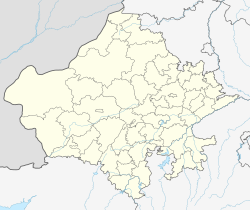Kirti Stambha
12th-century tower at Chittor Fort in Chittorgarh, Rajasthan, India From Wikipedia, the free encyclopedia
Kirti Stambha is a 12th-century tower situated at Chittor Fort in Chittorgarh town of Rajasthan, India.
| Kirti Stambha | |
|---|---|
 Kirti Stambha | |
| Religion | |
| Affiliation | Jainism |
| Sect | Digambara |
| Deity | Rishabhanatha |
| Festivals | Mahavir Janma Kalyanak |
| Location | |
| Location | Chittor Fort, Chittorgarh, Rajasthan |
| Geographic coordinates | 24°53′32″N 74°39′0″E |
| Architecture | |
| Type | Tower |
| Style | Māru-Gurjara architecture |
| Creator | Jeeja Bhagerwala |
| Date established | 12th century CE |
History
Summarize
Perspective

Chittor has a history going back several centuries. It was an ancient centre of Jain tradition. Chittor is adjacent to the ancient city of Madhyamika. The Jain inscriptions at Mathura from the Kushana period (1st–3rd centuries CE) mention a "Majjhimilla" branch of the "Kottiya" gana, indicating that it was a major Jain centre. The famous Acharya Haribhadra Suri (6th century CE) was born in Chittor and wrote "Dhurtopakhyana" there.[1]
There was a scholar Elacharya at Chittor from whom Vira-senacharya (9th century) learned the ancient Shat-khandagama and Kashayapahuda.[2] Virasena later wrote the famous "Dhavala" and "Jayadhavala" on the basis of these books.
The 22 metres (72 ft) tower was built by a Jain merchant Jeeja Bhagerwala during the reign of Rawal Kumar Singh in c. 1179–1191 CE.[2][3][4][5] It was the residence of Jinavallabha who propagated the Vidhimarga in the 12th century. From the 15th to 17th centuries, it was the seat of a Bhattaraka.[6]
Three inscriptions have been found that mention Jija of Bagherwal community as the builder of the stambha.[7] One of the inscriptions mention Dharmakirti, the disciple of Shubhakirti, who was disciple of Vasantkirti.[6] According to the Balatkara Gana Pattavali, Dharmakirti headed the patta during 1224-1257 CE. Thus the structure dates from the 13th century, although an unrelated Jain inscription of 896 CE was found in the vicinity.[8] Kirti Stambha is older than another tower in the same fort, known as the Vijay Stambha (Tower of Victory).[9]
Architecture

The tower is built in the Solanki style. The tower is 75 feet (23 m) tall. The tower is known for its intricate carvings and architecture. The seven storey temple is adorned by sculpture and mouldings from the base to summit. The carvings on each summit is different from other. The tower stands near the Saat-Bees Jain temple.[4]
The lower level is called Hansh Peeth, then Sinha-mukh Thar, Gaja Thar and Nava Thar.[4]
Gallery
- A recent photo of the tower standing tall in Chittor
- Mahavir temple with Kirti Stambha
- Mahavir Jain temple
- Saat-Bees Jain temple near Kirti Stampla
See also
References
External links
Wikiwand - on
Seamless Wikipedia browsing. On steroids.





